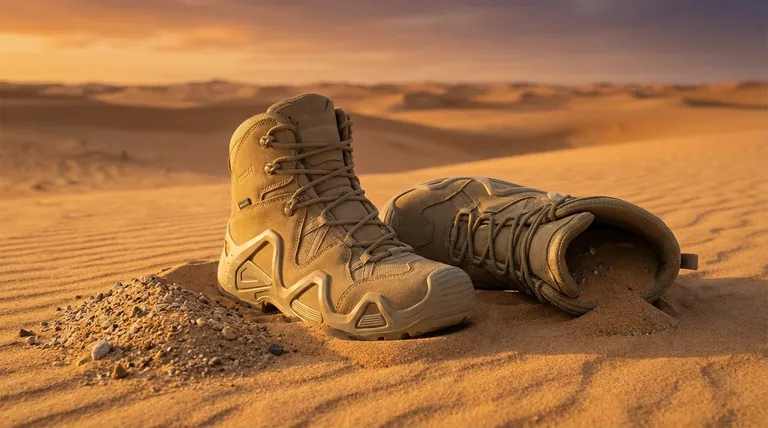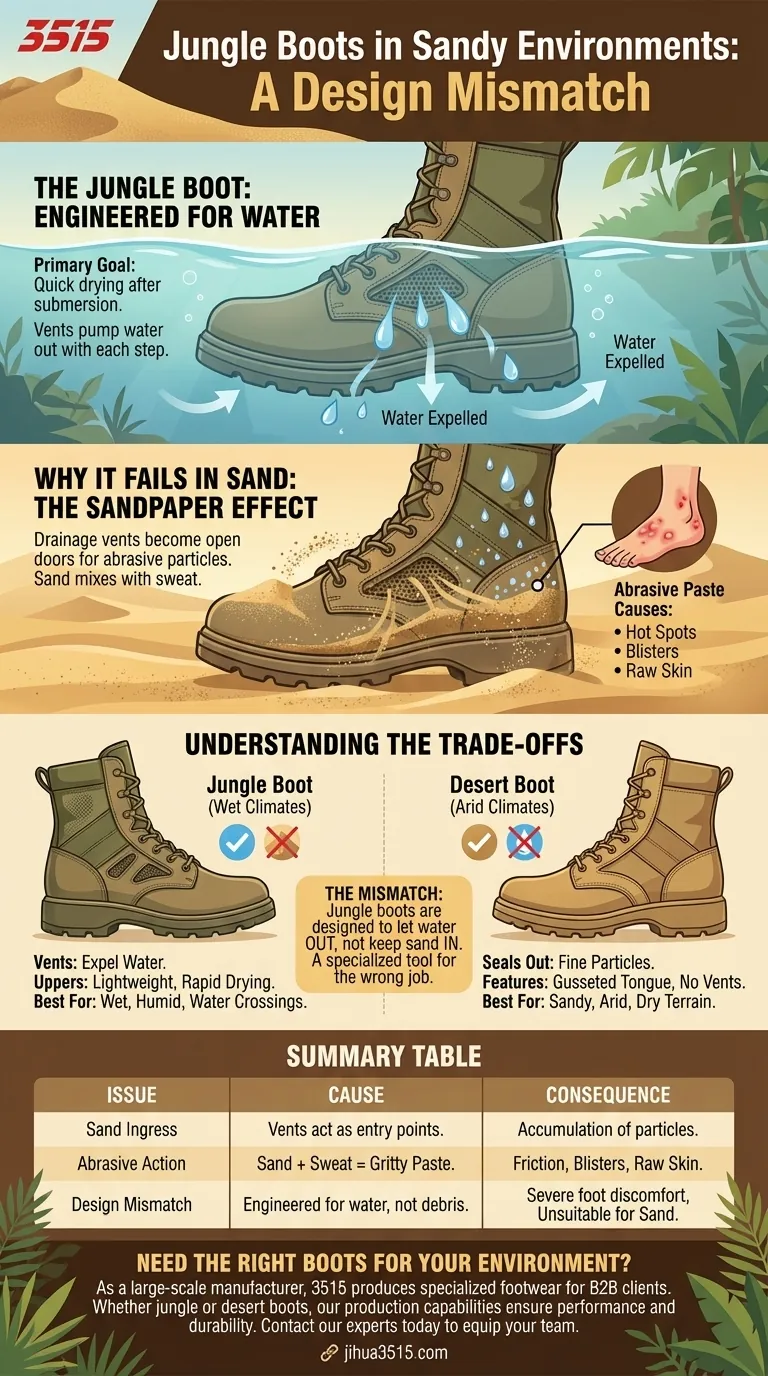In a sandy environment, the defining feature of a jungle boot becomes its greatest liability. The drainage vents located near the bottom of the boot, which are essential for expelling water in wet climates, act as open doors for fine sand and silt. This ingress of abrasive particles can quickly lead to severe foot discomfort, blisters, and abrasions.
The core issue is a fundamental design mismatch: jungle boots are engineered to let water out, not to keep fine particles from getting in. This makes them an exceptionally poor choice for sandy or arid terrains where sealing out debris is the primary challenge.

The Design Principle of the Jungle Boot
Engineered for Water, Not Sand
The classic jungle boot was developed for hot, wet, and humid environments where soldiers frequently crossed streams or trudged through marshes. Its primary design goal is not to keep feet dry, but to allow them to dry as quickly as possible after being submerged.
The Critical Role of Drainage Vents
To achieve this, jungle boots feature small, often screened, vent holes or eyelets near the instep. With each step, the compression and flexion of the foot actively pump water out through these vents.
Breathability and Quick Drying
This drainage system works in tandem with lightweight canvas or nylon uppers. These materials do not retain water like heavy leather and, combined with the airflow from the vents, facilitate rapid drying.
Why This Design Fails in Sand
The "Sandpaper Effect"
When you walk in sand, these same drainage vents scoop up fine grains with every step. Once inside, the sand mixes with sweat to form an abrasive paste.
Abrasive Action with Every Step
This gritty mixture is trapped against your sock and skin. The constant motion of walking grinds this paste into your foot, creating friction that rapidly leads to hot spots, blisters, and raw skin.
No Easy Exit
Unlike water, sand does not get pumped out of the vents. It simply accumulates, worsening the abrasive effect over time and making it impossible to walk without stopping to empty the boots completely.
Understanding the Trade-offs: Environment-Specific Footwear
The Jungle Boot's Double-Edged Sword
The jungle boot is not a flawed design; it is a highly specialized tool. Its exceptional ability to handle water is precisely what makes it fail in desert conditions. The feature that saves your feet in a swamp will destroy them in the sand.
The Desert Boot: An Opposite Philosophy
Dedicated desert combat boots are engineered with the opposite goal: to seal out fine particulates. They achieve this with features like fully gusseted tongues (sewn to the boot along the sides), a higher ankle, and a complete lack of low-placed drainage vents.
The Inherent Compromise
The trade-off is clear. A desert boot that is excellent at keeping sand out will be terrible at draining water if submerged. It will become extremely heavy and take a very long time to dry, creating its own set of risks in a wet environment.
Making the Right Choice for Your Environment
Ultimately, the effectiveness of your footwear depends on selecting the right tool for the job.
- If your primary environment is wet, humid, or involves frequent water crossings: The jungle boot's drainage capability is a critical advantage.
- If your primary environment is arid, desert, or features fine sand and silt: You must prioritize a sealed boot, like a desert boot, that is designed to prevent particle entry.
- If you face a mixed environment with uncertain terrain: Consider a modern, non-vented waterproof boot combined with a good pair of gaiters to create a physical barrier against both debris and water.
Choosing the right footwear begins with a clear understanding of your specific environmental challenge.
Summary Table:
| Issue | Cause | Consequence |
|---|---|---|
| Sand Ingress | Drainage vents act as entry points for fine sand. | Accumulation of abrasive particles inside the boot. |
| Abrasive Action | Sand mixes with sweat, creating a gritty paste. | Causes friction, leading to hot spots, blisters, and raw skin. |
| Design Mismatch | Boots are engineered to expel water, not seal out debris. | Severe foot discomfort, making them unsuitable for sandy environments. |
Need the Right Boots for Your Specific Environment?
As a large-scale manufacturer, 3515 produces a comprehensive range of specialized footwear for distributors, brand owners, and bulk clients. Whether you need jungle boots for wet climates or sealed desert boots for sandy terrains, our production capabilities encompass all types of shoes and boots designed for performance and durability.
Let us help you equip your team with the perfect footwear solution. Contact our experts today to discuss your specific needs and volume requirements.
Visual Guide

Related Products
- Wholesale Waterproof Tactical Boots Custom Suede & High-Traction Soles
- Wholesale Lightweight Tactical Boots Custom Manufacturer for Desert & Combat Use
- Wholesale Lightweight Tactical Boots with Dial Closure OEM & Bulk Orders
- Durable Leather Tactical Boots Wholesale & Custom Manufacturing for Brands
- Durable Leather High-Ankle Tactical Boots for Wholesale & Custom Manufacturing
People Also Ask
- What are the advantages and disadvantages of waterproof tactical boots? A Guide to the Key Trade-Offs
- What waterproof technology is used in tactical boots? Unlock All-Weather Performance & Protection
- Why is waterproofing important for tactical boots? Protect Your Feet and Gear in Any Mission
- What is the significance of waterproof functionality in tactical boots? Essential for Health & Performance
- Why is waterproofing important in tactical boots? Essential for Foot Health & Mission Success



















